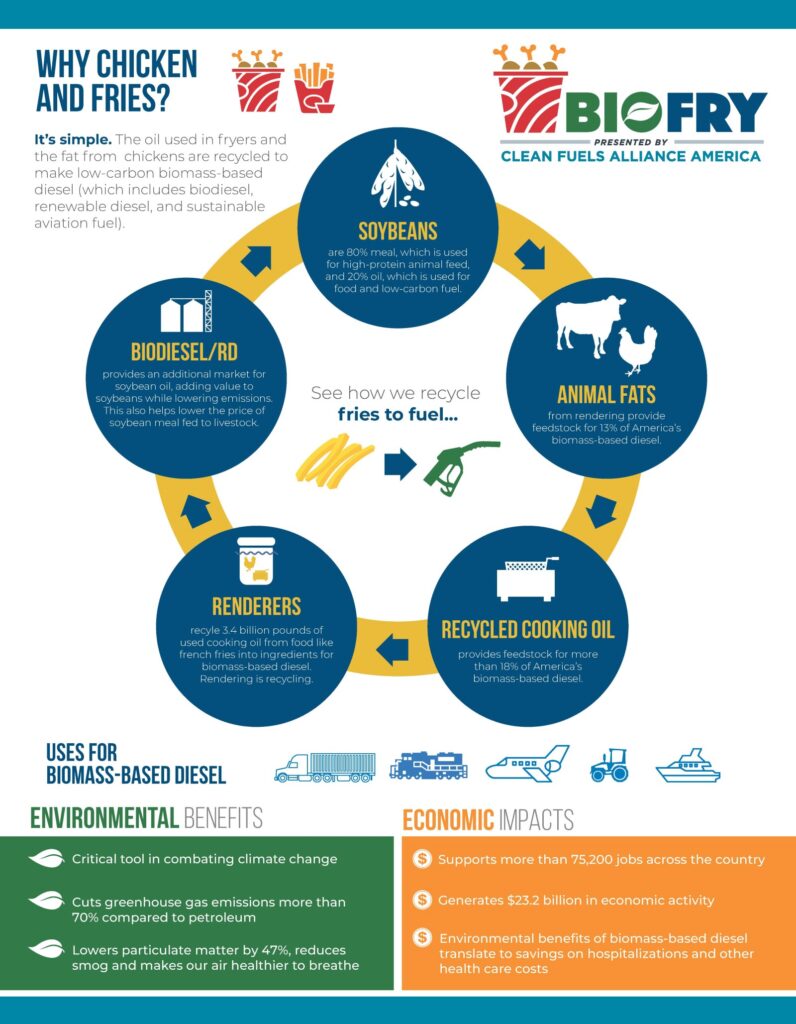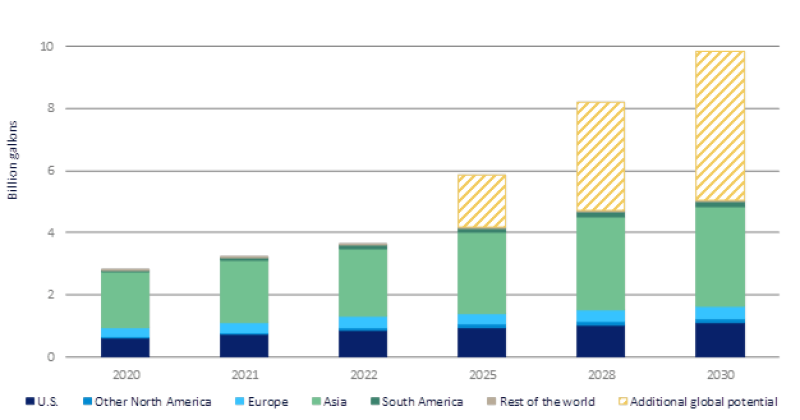The post New Markets Provide Sunnier Outlook For Clean Fuels appeared first on Clean Fuels Alliance America.
]]>Published in Biodiesel Magazine | Summer Issue
Tremendous growth in the biomass-based diesel industry should be celebrated by producers and farmers, as well as those who enjoy breathing cleaner air and lower greenhouse gas emissions. However, that growth coupled with disappointing Renewable Fuel Standard volumes set by the U.S. Environmental Protection Agency have put stress on the industry. Despite the current storm created by these conditions, new markets rapidly coming online provide a sunnier outlook for the years ahead.
In 2023, biomass-based diesel (BBD) consumption reached just under 4.6 billion gallons. Out of total diesel fuel consumed in the United States in 2023, BBD accounted for around 8%, a significant growth from recent years (approx. 5.5% in 2022). The U.S. Energy Information Agency’s most recent data, which is current through February, shows biodiesel production capacity has remained relatively steady at 2.1 billion gallons per year (BGY), while renewable diesel capacity has expanded up to 3.9 BGY (from 2.2 BGY as recent as October 2022). The main driver for this growth continues to be states with a Low Carbon Fuel Standard. California’s market remains strong, with consumption making up approximately 60% of its entire diesel pool.
Looking forward, renewable diesel capacity expansions and greenfield projects are continuing well into 2024 and parts of 2025. Currently, around 1.65 BGY of renewable diesel production capacity is expected by the end of 2025 in the U.S., with an additional 300 million gallons per year (MMgy) sanctioned in Canada. Sustainable aviation fuel (SAF) projects also continue apace, with an approximate 600 MMgy of production capacity expected by the end of 2025, with the majority of near-term growth coming from the familiar hydroprocessed esters and fatty acids (HEFA) production pathway.
This unprecedented growth eclipsed what the EPA forecasted, greatly exceeding the set rule for 2023. When the set rule was released in June 2023, it was readily apparent that BBD would easily outpace the D4 volume.
LCFS credit prices across the West Coast are also down from recent highs. Recently, there has been huge growth in credit generation, led by BBD, renewable natural gas and electrical vehicle adoption. Looking at the California LCFS, there is currently over 23 million metric tons of LCFS credits in the California credit bank. This is significantly pulling LCFS credit prices down. This is not only occurring in California but in all LCFS states, just not to the same degree.
Although these lower credit prices are concerning for producers, there is reason for hope with growing demand. New markets have been developing in recent years, due to many corporate initiatives to reduce greenhouse gas emissions and lower their collective carbon footprint. Both the rail and maritime industries are primed and ready to begin their transition to lower-carbon fuel sources. Both biodiesel and renewable diesel fit perfectly into their corporate structures, as they can be used as drop-in fuels.
An estimated 80% of the world’s goods are transported by sea, making low-carbon fuel critical for corporations that have made aggressive carbon reduction commitments. Biodiesel sales in marine markets are growing rapidly throughout the world, with B24 blends being sold in high quantities in Singapore and high quantities of B30 blends being sold in northwest Europe.
These companies would like to increase their uptake in biodiesel and renewable diesel blends in the U.S., a 7-billion-gallon market, but there are some hurdles—namely, the inability for ocean-going vessels to get the benefits of renewable identification numbers (RINs). Reps. Mariannette Miller-Meeks, R-Iowa, and John Garamendi, D-California, have introduced legislation aiming to increase the use of renewable biofuels used by sea vessels. By designating renewable fuel used in ocean-going vessels as an “additional renewable fuel” under the RFS, the Renewable Fuel for Ocean-Going Vessels Act would enable companies to preserve RINs in the program. U.S. Sens. Pete Ricketts, R-Nebraska, and Sherrod Brown, D-Ohio, introduced a similar version of the bill in the Senate, and thus far, the bill has shown signs of bipartisan support.
Railroads are another difficult-to-decarbonize sector with dreams of a cleaner future. The rail market is 4 billion gallons in the U.S., and we project that more than 20% will be BBD before the end of the decade. Multiple Class I railroad companies have been setting lofty goals for biodiesel use in their engines as early as 2030. Union Pacific, BNSF and Canadian National, along with other Class I railroads, are already making strides, successfully testing up to 100% BBD.
While there are near-term headwinds for our industry as discussed above, long-term tailwinds are right around the corner. Demand for BBD fuel is going to continue to grow as existing markets expand, and the benefits of these fuels continue to reach new markets.
The post New Markets Provide Sunnier Outlook For Clean Fuels appeared first on Clean Fuels Alliance America.
]]>The post Heating Oil Industry on Track to Achieve Net-Zero Emissions by 2050 appeared first on Clean Fuels Alliance America.
]]>According to a new analysis by Dr. Tom Butcher of the National Oilheat Research Alliance (NORA), the industry has surpassed its goal of reducing GHGs 15% by 2023, achieving a nearly 26% reduction in greenhouse gas emissions through a combination of energy efficiency improvements and increased use of renewable fuels such as Bioheat® Fuel, a blend of sustainable biodiesel with conventional home heating oil.
“The heating oil industry has made significant strides in reducing its carbon footprint over the past five years,” said Sean Cota, President & CEO of the industry’s Washington-based trade association, the National Energy & Fuels Institute (NEFI).
“These mostly small, multi-generational family businesses are playing an outsized role in carbon reduction in the Northeast,” Cota added. “They will continue to prove pivotal in the years to come as governments at all levels seek to achieve ambitious greenhouse gas reduction goals in a manner that is equitable and achievable, and that preserves energy security and reliability.”
At its sixth annual industry summit, held in Weehawken, New Jersey this week, the industry celebrated numerous successes and innovations, including:
- UL standards that recognize higher biofuel blends in oil-fired heating equipment
- Manufacturers introducing burners and heating systems to the market that are certified for blends of up to 100% biodiesel (B100)
- New federal tax credits for homeowners who upgrade to more efficient oil-fired furnaces and boilers that are designed for use with higher blends of renewable fuels
- Securing federal grants for downstream biofuel infrastructure investments for heating oil
Working closely with state governments, heating oil state associations advocated for biofuel blending requirements in Connecticut, New York and Rhode Island that will eventually require blends as high as 50-percent. Additionally, heating oil blended with biofuels are expected to generate credits under emerging “clean heat standards” now being developed in Massachusetts and Vermont, and in the early stages of development in several other Northeast states.
Renewable fuels have proven to be an immediate, cost-effective, and equitable means of reducing emissions in the building sector, particularly for the nearly five million Northeast homes and businesses that rely on heating oil dealers for warmth and comfort each winter.
“There is still work ahead, and we are ready for the challenge,” said NEFI Board Chair Ray Hart, a full-service heating oil dealer based out of Long Island, New York.
“This is an industry of hard-working American men and women that care deeply for their neighbors, their local communities, and the environment,” he said. “Together, we can achieve great heights.”
ABOUT THE NATIONAL ENERGY & FUELS INSTITUTE (NEFI)
Since 1942, NEFI has been a leading voice for wholesale and retail liquid heating fuel distributors and related services companies in Washington, DC and throughout the country. Its members are mostly small, multigenerational family businesses that deliver warmth and comfort to millions of American homes. NEFI hosts annual summits, such as today’s event in Weehawken, NJ, that provide an opportunity for stakeholders to gather and discuss pathways to voluntarily achieve carbon reduction goals consistent with industry commitments, including widespread deployment of renewable liquid heating fuels and high efficiency technologies. More at www.nefi.com.
Contact: Heather Buechter, 479-651-7301, hbuechter@cleanfuels.org
The post Heating Oil Industry on Track to Achieve Net-Zero Emissions by 2050 appeared first on Clean Fuels Alliance America.
]]>The post Used Cooking Oil Outlook 2023 appeared first on Clean Fuels Alliance America.
]]>The post Used Cooking Oil Outlook 2023 appeared first on Clean Fuels Alliance America.
]]>The post U.S. Economic Impact of the Clean Fuels Industry appeared first on Clean Fuels Alliance America.
]]>The post U.S. Economic Impact of the Clean Fuels Industry appeared first on Clean Fuels Alliance America.
]]>The post Clean Fuels Industry Benefits appeared first on Clean Fuels Alliance America.
]]>The post Clean Fuels Industry Benefits appeared first on Clean Fuels Alliance America.
]]>The post Study: The Economic Benefits of the Biodiesel Blenders’ Credit appeared first on Clean Fuels Alliance America.
]]>The post Study: The Economic Benefits of the Biodiesel Blenders’ Credit appeared first on Clean Fuels Alliance America.
]]>The post BioFry Event Illustrates Industry Coordination appeared first on Clean Fuels Alliance America.
]]>
The annual event serves attendees snacks of chicken and french fries to illustrate that soybeans are used in animal feed and food preparation while used cooking oil, surplus oil, and animal fats are recycled to make clean fuels. It provides an opportunity to educate the community about the benefits of biodiesel, renewable diesel, and SAF – which include adding value to the soybean and rendering industries.

Attendees were interested to learn that many DC work truck fleets use high biodiesel blends – including B100. Other attendees were more familiar with Clean Fuels, having participated in previous Clean Fuels Foundation education tours. The event created an opportunity to ncrease coordination among the industries, unify messaging, and build relationships with interested audiences.
The post BioFry Event Illustrates Industry Coordination appeared first on Clean Fuels Alliance America.
]]>The post Clean Fuels Releases Outlook on Global Supplies of Used Cooking Oil for Biodiesel and Renewable Diesel Production appeared first on Clean Fuels Alliance America.
]]>“Growing demand for better, cleaner fuels like biodiesel, renewable diesel and SAF is creating a tremendous opportunity to develop additional supplies of low-carbon fats and oils, including used cooking oil and surplus crop oils,” said Donnell Rehagen, CEO of Clean Fuels Alliance America. “Our industry envisions sustainably producing 6 billion gallons of clean fuels by 2030, and this report identifies crucial additional feedstocks. Our vision supports national goals to decarbonize aviation and other heavy-duty transportation sectors.”
Access the report on cleanfuels.org/sustainable-impact/.
Forecast global UCO supplies to 2030

The report indicates that the United States has the most well-developed UCO collection system, due to long-standing practices for its use and disposal. In 2022, the U.S. supply reached 850 million gallons. Increasing biodiesel and renewable diesel production is incentivizing domestic use of that supply – curbing recent export trends. The report identifies additional room for growth in U.S. collection to 1.1 billion gallons.
Global UCO trade reached 1.3 billion gallons in 2022. The majority of collected UCO supplies moved from Asia to Europe. The report identifies the potential to increase UCO collection in Asia, South America and Europe to meet global demand for biodiesel, renewable diesel and SAF. Additional collection could be achieved in those countries with U.S.-style collection practices.
Contact: Paul Winters, 202-737-8803, pwinters@cleanfuels.org.
Materials supported by United Soybean Board, soybean farmers and their checkoffs.
The post Clean Fuels Releases Outlook on Global Supplies of Used Cooking Oil for Biodiesel and Renewable Diesel Production appeared first on Clean Fuels Alliance America.
]]>